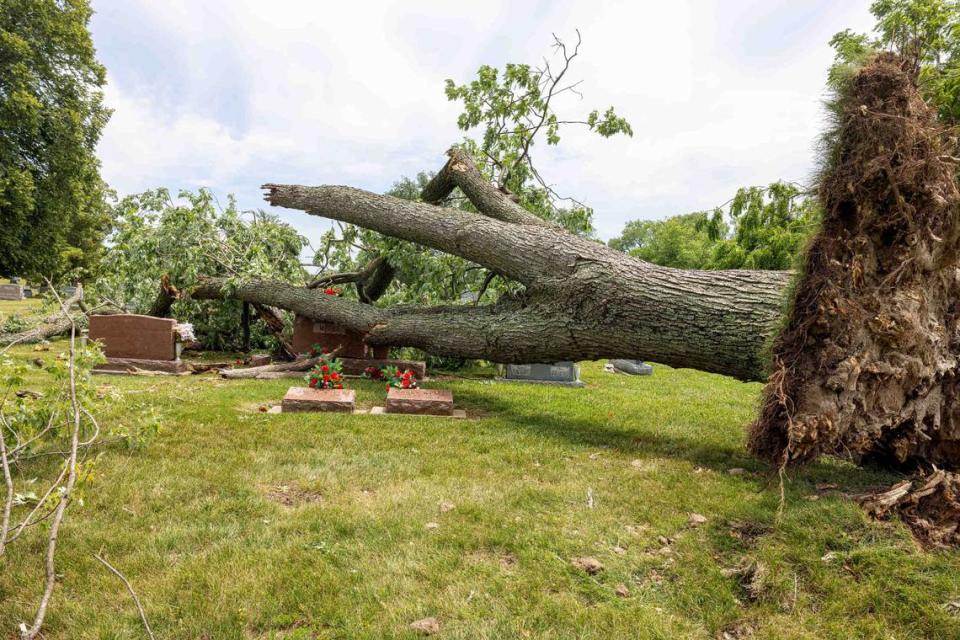Thousands still without power in Illinois as Ameren contends with worst outage in years
Three violent storms in three days has made power restoration in the metro-east so problematic, a spokesperson for Ameren said Monday afternoon.
Brian Bretsch, public and media relations manager for Ameren, said a derecho that hit parts of central Illinois on Thursday, combined with the thunderstorms that blew through the metro-east Friday and Saturday have kept crews busy in their effort to restore electricty to homes and businesses.
“What makes this so unique is not only having three storms in three days but each storm hitting different parts of our service territory and all three storms featuring intense winds,” Bretsch said. “I was driving back through Decatur and going through some of those communities, it wasn’t a branch here or a limb there, but full trees being blown over into our power lines.
“Trees 50-60 feet from our power lines were being blown over. The winds were so intense they were knocking entire trees down.”
The intense heat with temperatures near triple digits Thursday-Friday, combined with the haze from the Canadian wildfires also have hampered restoration efforts, Bretsch noted.
“We tell our workers we want them to be safe, take a break, get out of the hazy stuff so you’re not hacking and coughing ... we have to keep our team of lineworkers safe and want to do everything right so no one gets hurt,” Bretsch added. “We talk about rehydration, rehydration and safety. “
Bretsch said at the peak, 225,000 Ameren customers were without power due to the storms. As of 3 p.m. Monday , according to the Ameren power outage map, 20,132 Illinois residents remained without power. Locally, that includes customers in the metro-east:
Belleville: About 87
Smithton: About 182
Columbia: About 1,028
Collinsville: About 662
Granite City: About 842
Nashville: About 999
According to an Ameren press release, as of Monday afternoon, approximately 200,000 customer outages had been restored since the storms began Thursday. Additionally, the press release noted, about 1,300 poles have been damaged or destroyed.
“We have more crews on the ground restoring power,” Bretsch said. “We have contractors and utilities from 12 other states trying to clean this up. We haven’t had anything like this in our service territory with this many customer outages since 2006. This all stems from having three separate storms featuring intense winds right on top of each other in three parts of our service territory.”
Bretsch said the situation actually could have been worse.
“Without adding smart technology and without a hardening of our technology system, we estimated a far bigger issue,” he said. “Even though it’s a terrible inconvenience for our customers who lost power and are still without power, things could have been far worse if we didn’t have this technology in place and continue to have this technology in place.”
Who gets top priority in these situations?
Ameren employes a priority system to determine which power lines get repaired first. Bretsch said they start with critical/Tier 1 customers, which includes hospitals, nursing homes, police stations, fire stations, etc., because, “What they do is critical by nature,” he added.
After that, Bretsch said they focus on restoring power to the largest amount of customers at once and that they do not base this on individual communities.
“Each storm we look at it like a grid,” he said. “Can we re-route power from another source to another area? So if there’s a limited amount of damage and, guess what, if we go into that area and it’s going to bring back 2,000 customers, let’s do that repair first vs. a repair that might only bring back 15 customers.
“So, it’s critical customers first. From there, we then go down to neighborhoods where we can the most people restored at once ... the situations where we can only bring back two or three people, unfortunately, they’re the last ones we go to. Basically, we just try to get as many people back up at once as possible.”
Crews on the way
Bretsch said Ameren still has crews in central Illinois wrapping up restoring power. Once they’re done, they will head back to the metro-east to assist, he said.
“We’re keeping crews there to finish off all those little small pockets,” he said. “We want to get as many of those people wrapped up as possible. As they finish those jobs, let them get their six-eight hours of sleep and then they’ll be down here in the metro area ... depending on how long they’ve worked, when they started, etc., then they’ll roll down here. A lot of our people have worked overnight as well.”
Bretsch also noted the difficulty Ameren workers face when leaving their families behind without power.
“The other hard part is, after all this, all of our lineworkers and line support people are leaving their families in the dark without power and in a warm house to help other families,” he said. “I always commend them for that. They take great pride in restoring people quickly and safely. This one has just been extraordinary because we had three storms right in a row.”
More info for metro-east residents
Here is additional information to assist customers:
Ameren Illinois customers who have reported an outage or signed up for alerts will receive notification on the status of their individual outage. Go to AmerenIllinois.com/outage.
If a home or business has been damaged by severe storms, the customer may need to make specific repairs before Ameren can restore power. Learn more here: Storm Damage to Weatherheads on Vimeo.
Customers and media can receive updates on outage restoration by following the Ameren Illinois news feed at twitter.com/AmerenIllinois and Facebook.com/AmerenIllinois.



